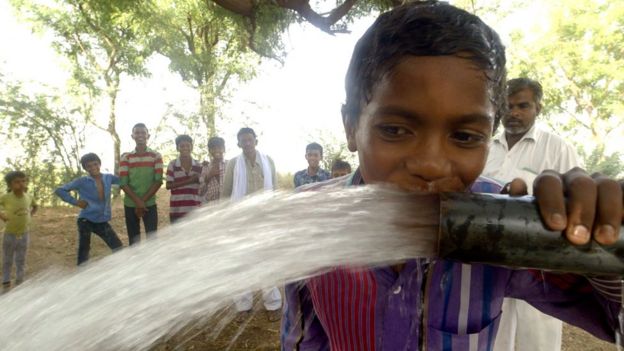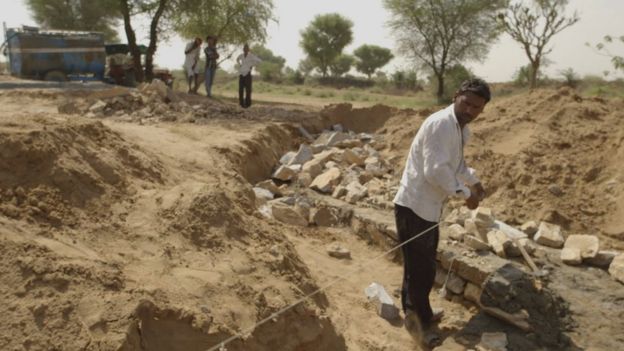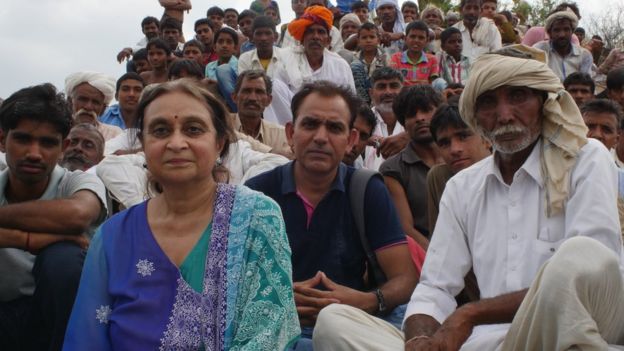It is easy to underestimate Amla Ruia.
But 71-year-old, this respectable chair is very talented. One of the world's most dumped crews is one of the leading players in India's struggle against drought.
More than 300 million Indian people face severe water scarcity annually. The government has been forced to distribute water and water through trains and tanks to state farms and tanks, as monsoons are lying in recent years.
Water should be taken in a nearby well, but the number of people dying of water in the body has increased as people have to go a long way.
One of the largest states in India, one of the largest states of Rajasthan drought. Amarurya and her Hari Nair are also working here.
They have built over 200 checkpoints over the last 10 years and have improved life and livelihood in more than 115 villages. As a result, its impact on their 193 surrounding villages has occurred.
Ancient times
The NGO is working with local communities to find areas where water is reserved for reservoirs.
Instead of man-made freshwater reservoirs, using natural landscapes in mountainous areas. They build up the slopes. Strengthening the watering areas and keeping water on these partial natural water floors.
The underground water level, which has fallen in time and has been deteriorated over time, increases as the monsoon rains fall. Water collected in wells and wells near villages is used for dry periods.
These are constructed at low cost. Furthermore, such large-scale dams and reservoirs are not mandatory for people to migrate.
"It's not a new solution, it's been observed by our ancestors," says Amararaya.
"We build a solid concrete wall amongst our configurations, so as the water level increases, the water will rise easily, and the other side will easily pass through," says Akkara Nair's engineer Digipal Sinha.
"Other walls are constructed with soil, and the normal soil is used in the land, all of which are mostly made of soil."
"When you come in, you go directly into the soil, increase the underground water and increase the water's wells in the surrounding area," he says.
Disappointment on the charity
This charity company, which provides 60% of resources to create prevention, asks the local community to provide the remaining 40% of the fund.
Restrictions should be maintained regularly. He said investments made by villages and farmers would become the owners of them, and they could go to work in a different place hoping that they will be properly maintained and rewarded.
"First, villagers were not ready to trust us, they thought we had intentions." Amarouya remembers the days when they started work.
But 71-year-old, this respectable chair is very talented. One of the world's most dumped crews is one of the leading players in India's struggle against drought.
More than 300 million Indian people face severe water scarcity annually. The government has been forced to distribute water and water through trains and tanks to state farms and tanks, as monsoons are lying in recent years.
Water should be taken in a nearby well, but the number of people dying of water in the body has increased as people have to go a long way.
One of the largest states in India, one of the largest states of Rajasthan drought. Amarurya and her Hari Nair are also working here.
They have built over 200 checkpoints over the last 10 years and have improved life and livelihood in more than 115 villages. As a result, its impact on their 193 surrounding villages has occurred.
Ancient times
The NGO is working with local communities to find areas where water is reserved for reservoirs.
Instead of man-made freshwater reservoirs, using natural landscapes in mountainous areas. They build up the slopes. Strengthening the watering areas and keeping water on these partial natural water floors.
The underground water level, which has fallen in time and has been deteriorated over time, increases as the monsoon rains fall. Water collected in wells and wells near villages is used for dry periods.
These are constructed at low cost. Furthermore, such large-scale dams and reservoirs are not mandatory for people to migrate.
"It's not a new solution, it's been observed by our ancestors," says Amararaya.
"We build a solid concrete wall amongst our configurations, so as the water level increases, the water will rise easily, and the other side will easily pass through," says Akkara Nair's engineer Digipal Sinha.
"Other walls are constructed with soil, and the normal soil is used in the land, all of which are mostly made of soil."
"When you come in, you go directly into the soil, increase the underground water and increase the water's wells in the surrounding area," he says.
Disappointment on the charity
This charity company, which provides 60% of resources to create prevention, asks the local community to provide the remaining 40% of the fund.
Restrictions should be maintained regularly. He said investments made by villages and farmers would become the owners of them, and they could go to work in a different place hoping that they will be properly maintained and rewarded.
"First, villagers were not ready to trust us, they thought we had intentions." Amarouya remembers the days when they started work.
The company has made tremendous changes in the lives of people.
Farmers, who have been receiving water for survival, are now producing trials and maintaining livestock. Amla Ruya says that the girls who were looking at home jobs could now go to school because the mother had to go far away for drinking water.
Aakar volunteer company has been building an average of 30 checkpoints annually with local communities, but it has been increased three times and Amla Ruya wants to create 90 barracks annually. Amla Ruia wants to spread information about investments around the world.
But this is not a solution for everyone, "says activist Praful Katham, a local resident who works locally.
"These restrictions are very beneficial to the local people, so that farmers can cultivate seasonal crops in the future but there are some limitations on prevention, and this scheme does not apply to all parts of India that have different geographical systems." He says.
But this claim did not stop the work of Amaluraya.
"I once told my husband that I would look at my bumps until the age of 90. What would you do for the next 30 years?" Said Amla Ruya, "you are going to do the same until I am 120 years old.



Comments
Post a Comment